How Do Foam Pumps Work: The Ultimate Guide to It
Foam pumps are everywhere — in hand soaps, facial cleansers, even car detailing products.
But how exactly do they work?
If you’re a product developer, packaging buyer, or brand owner exploring foam dispensing solutions, understanding the mechanics behind foam pumps isn’t just nice-to-know — it’s essential for making the right technical and sourcing decisions.
At first glance, a foam pump might look just like a regular lotion pump. But inside, it’s a precision-engineered system designed to mix liquid and air in real time — producing rich, stable foam with no propellant and minimal effort.
This guide breaks it all down:
* The internal components that make it possible
* What kind of liquids are compatible (and which aren’t)
* How it differs from regular pumps
* Where it’s used and why it matters for modern brands
Whether you’re scaling up a skincare line or designing a custom dispenser for your latest product, this is your one-stop resource.
At Vanjoin, we’ve helped hundreds of global brands create customised foam pump packaging — from custom-coloured PP bottles to airless foam solutions.
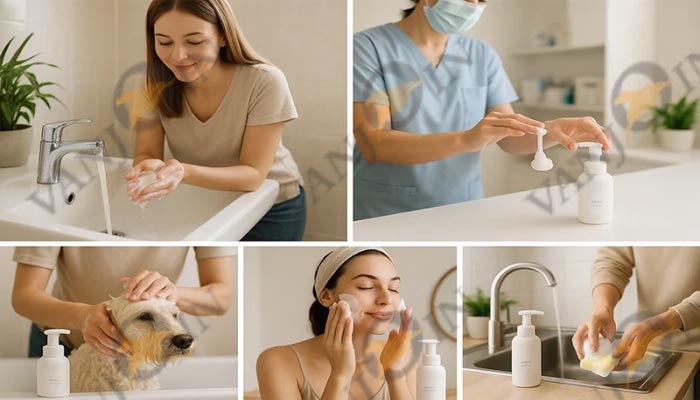
What Is a Foam Pump Dispenser?
A foam pump is a non-aerosol dispensing system that turns liquid formulations into foam — all through a clever mix of air, liquid, and physical filtration.
Unlike regular pumps that dispense liquid directly, foam pumps draw in both liquid and air, mix them inside a chamber, and push the mixture through a fine mesh to generate pre-lathered foam. This dual-action mechanism allows for precise mixing and consistent foam output.
This eliminates the need for users to rub the product into foam themselves, improving convenience, hygiene, and product experience.
From hand soaps to facial cleansers, foam dispensers are now widely used across personal care, healthcare, and household cleaning sectors — valued for their ability to deliver just the right amount of product in a light, airy texture.
At Vanjoin, we manufacture fully customisable foam pump bottles in PP and PET — ideal for brands looking to reduce product waste, cut down on surfactants, and stand out with user-friendly, high-performance packaging.
Key features of a foam pump dispenser
* Pre-foams liquid without aerosols or propellants
* Works best with low-viscosity, water-based formulas
* Dispenses a consistent, soft foam with each stroke
* Compatible with sustainable, refillable packaging designs
Foam pumps aren’t just a dispensing tool — they’re part of a growing trend toward smarter, cleaner, and more eco-conscious product delivery systems.
How Does a Foam Pump Actually Work?
At first glance, a foam pump looks simple.
But inside, it’s a precisely engineered system that transforms liquid into foam — using nothing but air, pressure, and smart design.
Here’s how it works, step by step:
Step 1: Air and Liquid Intake (The Dual Channel System)
When the user presses the pump head, the actuator triggers two things simultaneously:
* Liquid is pulled up through the dip tube from the bottle, thanks to the vacuum pressure created by the piston.
* Air is drawn in through a separate intake hole, usually located on the side or beneath the actuator.
This creates a 1:3 to 1:5 air-to-liquid ratio — ideal for generating foam.
Vanjoin’s foam pumps are designed with precise air-liquid intake chambers to ensure consistent mixing across viscosities.
Step 2: Turbulent Mixing in the Chamber
Inside the pump, the incoming liquid and air are channeled into a mixing chamber — a small internal space where turbulence occurs.
As the liquid and air collide at high speed, they form a coarse mixture of tiny bubbles suspended in liquid. This “proto-foam” isn’t yet ready to dispense — but it’s the foundation.
Think of this like shaking soap and water together in a bottle — only it happens in a fraction of a second, with engineered precision.
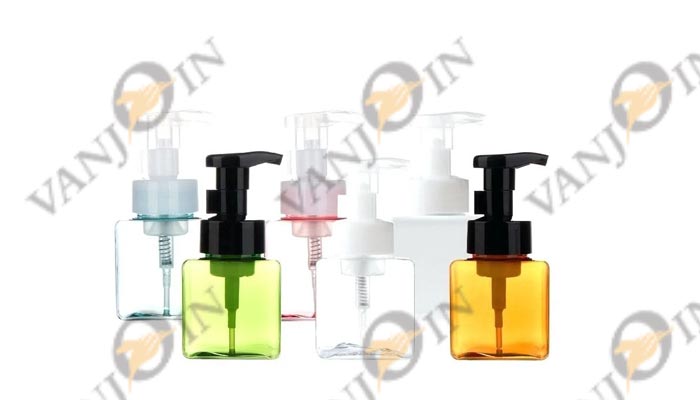
Step 3: Foam Generation Through the Mesh
The semi-mixed air-liquid solution is then forced through a fine mesh screen — often made from stainless steel or food-grade nylon with pores as small as 10–50μm.
As the mixture is pushed through this mesh:
* The liquid is broken into micro-droplets
* Each droplet binds with air, forming a dense, uniform foam
The result is a smooth, stable foam that’s immediately ready to use — no shaking, no rubbing, no delay.
At Vanjoin, we use multi-layer mesh filters for maximum foaming consistency — ideal for everything from cleansers to alcohol-based hand sanitizers.
Step 4: Reset and Refill
When the user releases the pump head, internal springs push the piston back to its original position.
* A check valve closes the outlet to prevent air backflow
* A ball valve at the base of the dip tube opens to draw in fresh liquid
* The air chamber resets for the next cycle
This ensures every pump delivers the same volume and foam quality — whether it’s the first use or the five-thousandth.
Bonus Note: No Propellants, No Aerosols
Foam pumps rely 100% on mechanical motion — no gas cartridges, no pressurised cans.
This makes them:
* Safer for transportation
* More eco-friendly
* Refillable and recyclable — especially when paired with PP-based bottles or simplified material structures.
Vanjoin is actively exploring more sustainable foam pump solutions, including reduced component count and easier disassembly
Key Components Inside a Foam Pump
Behind every smooth, airy pump of foam is a complex assembly of precision parts — each playing a specific role to ensure proper air-liquid mixing, foaming efficiency, and durability.
Let’s break it down.
| Component | Function | Notes & Vanjoin Insight |
| Actuator / Pump Head | tde part users press. Triggers tde entire dispensing cycle. | Ergonomically designed to deliver smootd pressure and controlled output. |
| Spring Mechanism | Provides recoil after pressing; resets tde pump. | Vanjoin uses high-quality stainless steel springs, and is exploring simplified-material alternatives for future sustainability. |
| Air Chamber / Air Duct | Draws in ambient air to mix witd liquid. | Key for foam creation — precise sizing ensures stable ratios. |
| Liquid Chamber | Holds tde liquid temporarily during tde pumping cycle. | Must be leak-proof and compatible witd a wide range of viscosities. |
| Mixing Chamber | Where air and liquid turbulently mix before reaching tde mesh. | Often a vortex-style design for efficient blending. |
| Mesh Screen / Foaming Net | Breaks tde air-liquid mix into uniform bubbles — creates tde foam. | Vanjoin offers 10μm–50μm mesh options for different foam textures. |
| One-Way Valves | Prevents backflow of air or liquid; maintains hygiene. | Includes outlet valve and inlet ball valve — ensures clean, drip-free operation. |
| Dip Tube | Channels liquid from tde bottom of tde bottle into tde pump. | Custom lengtds available to fit 100ml–300ml bottles. |
| Gasket / Seal Ring | Ensures airtight sealing, prevents leaks and evaporation. | Typically made from silicone or rubber — also available in FKM for chemical resistance. |
Why Component Quality Matters
A foam pump is only as good as its parts.
If the spring tension is too weak, the pump won’t reset properly.
If the mesh is uneven, foam will be inconsistent.
If the valves fail, air–liquid ratios will shift, affecting output.
That’s why at Vanjoin, we manufacture foam pump components using:
* Food-grade or medical-grade PP, PETG, or nylon materials
* Tight injection moulding tolerances for high sealing performance
* Laser-cut or sintered mesh filters with micron-level accuracy
* Packaging-friendly designs that support recyclability and reduced part complexity
Whether you’re launching a luxury facial cleanser or an industrial hand sanitizer, the internal structure of your foam pump matters more than you think.
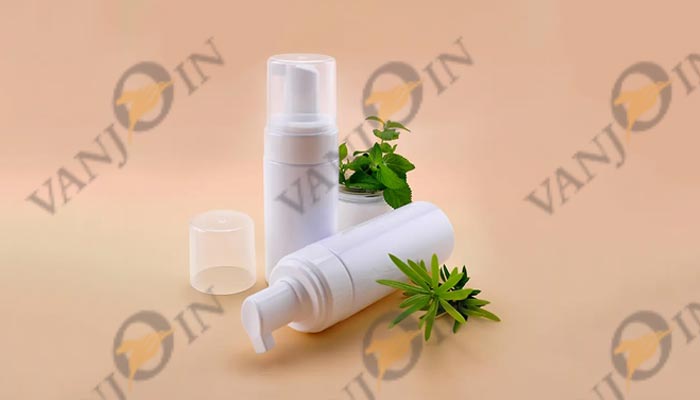
What Type of Liquids Work Best in Foam Pumps?
Foam pumps are clever — but not magic.
They rely on physical air-liquid mixing, not propellants or high pressure. That means the liquid formula inside matters a lot.
If the product is too thick, too oily, or lacks surfactants… it won’t foam.
If it’s too watery without structure… it’ll just squirt out with bubbles, not foam.
So what actually works?
Ideal Liquids for Foam Pumps
To produce a rich, stable foam, your formulation should meet the following criteria:
| Property | Recommended Range | Why It Matters |
| Viscosity | 1–200 cPs (low to medium) | tdin liquids mix better witd air and pass tdrough mesh easily. |
| Surfactant content | ≥5% (anionic, non-ionic, amphoteric) | Surfactants reduce surface tension — essential for foaming. |
| Foamability | High → dense, fine, stable foam | Determines foam texture and hold time. |
| Solids / oils | Low (<2%) | High oil or particulate content clogs mesh or prevents stable foam. |
| pH compatibility | 4.5 – 9 | Ensures compatibility witd most pump materials like PP, PETG. |
Common examples of foam-pump-friendly formulations:
* Foaming hand wash
* Facial cleansers
* Mild surfactant shampoos
* Sanitizing liquids (alcohol + surfactant blends)
* Pet shampoos
* Light surface cleaners
Formulas That May Not Work Well
Avoid the following unless the pump is specifically engineered for them:
* High-viscosity gels (e.g. aloe gel, styling gels)
* Oil-rich emulsions or cleansing oils
* Creams or lotions over 500 cPs
* Products with suspended particles (e.g. exfoliating beads)
* Pure alcohol or water with no surfactant
If you’re unsure, Vanjoin offers in-house formula compatibility testing — we’ll test your product on multiple pump types and recommend the best-fit configuration.
Can’t I Just Use My Regular Soap?
Not always.
Even a regular liquid soap might be too thick or not foamy enough when used in a foam pump bottle. Most commercial foam formulas are actually diluted — often 4 parts water to 1 part concentrate.
Pro Tip: Try testing your formula at 1:3, 1:4, or 1:5 dilution ratios and compare foam quality.
At Vanjoin, our foam pump systems are optimised for low-viscosity, surfactant-rich liquids — and we’re happy to advise on dilution guidance or custom bottle-pump matching to suit your formula.
Bonus: Foam Pumps Reduce Formula Waste
Because the liquid is pre-foamed during dispensing, users often require 30–50% less product per wash compared to standard liquid pumps — a bonus for both sustainability and cost control.
That’s why many brands are shifting toward foam-based packaging systems — less waste, better experience, and smarter delivery.
Foam Pump vs. Regular Pump: What’s the Difference?
At first glance, foam pumps and regular lotion pumps might look similar.
They both have a dip tube.
They both dispense with a push.
They can even fit the same bottle neck finishes.
But under the surface, they’re built for completely different purposes.
Side-by-Side Comparison
| Feature | Foam Pump | Regular Pump |
| Output Form | Pre-mixed foam | Liquid (gel, lotion, or fluid) |
| Mechanism | Mixes air & liquid tdrough mesh to generate foam | Pushes liquid directly out witd piston pressure |
| Internal Structure | Dual-chamber system witd air intake + mesh filter | Single chamber witd piston and spring |
| Formula Requirements | Works best witd diluted, surfactant-rich, low-viscosity liquids | Handles wide range of viscosities, including creams and gels |
| Foam Texture | Light, airy, ready-to-use | Requires user to latder manually |
| User Experience | Cleaner, faster, perceived as premium | Traditional, familiar |
| Common Use Cases | Hand soaps, facial cleansers, shaving foams, kids’ skincare | Lotions, conditioners, serums, oils |
| Packaging Perception | Modern, eco-conscious, usage-efficient | Functional, established |
| Material Complexity | More internal parts, precision-dependent | Fewer components, simpler design |
Why Choose Foam Over Liquid?
If your product is designed to cleanse, rinse, or spread easily (e.g. hand wash, facial cleanser), a foam pump can offer:
* More convenience – no lathering required
* Less waste – users tend to use 30–50% less product per wash
* Better perception – foam is often seen as gentler and more luxurious
Many skincare and hygiene brands switch to foam pumps not just for performance, but for branding impact. Foam feels softer, spreads quicker, and looks modern.
From a Packaging Perspective
Yes, foam pumps are structurally more complex — they include an air chamber, mixing zone, and fine mesh screen. That makes them slightly more expensive per unit.
But the cost is often offset by:
* Reduced formula volume
* Lower surfactant concentration
* Improved customer satisfaction and repeat use
At Vanjoin, we help brands evaluate whether a foam pump is the right fit based on product type, texture, and formulation goals — and recommend suitable bottle-pump combinations.
Still Unsure?
Here’s a quick rule of thumb:
* If your product should foam before it reaches the user’s hands → Go with a foam pump.
* If you want the user to control lather or if the product is thick/creamy → Use a regular pump.
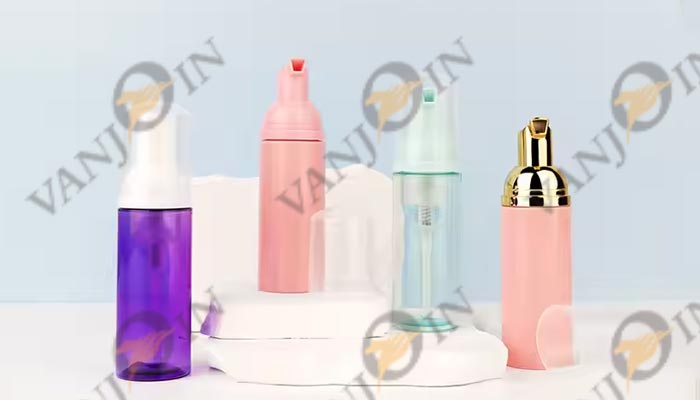
Advantages of Foam Pumps in Packaging
Switching to a foam pump isn’t just about aesthetics — it’s a strategic packaging upgrade.
For brands, foam pumps deliver measurable value across user experience, sustainability, product efficiency, and perception. Here’s why more and more companies are making the switch:
1. Better User Experience
Foam is fast. Foam is easy. Foam feels premium.
With a foam pump, the product is pre-lathered and ready to use straight from the bottle — no rubbing, no dripping, no waste.
* Perfect for one-handed use (great for kids, elderly, or in public settings)
* Feels gentler on skin — ideal for sensitive skincare lines
* Leaves less mess around sinks and counters
“Foam makes a product feel more modern, more considered, and more enjoyable — and customers notice.”
This aligns with principles of sensory branding, where tactile and visual experiences—like soft foam—can strongly influence consumer perception and loyalty.
2. Less Product Waste, More Cost Savings
Because foam expands and spreads easily, consumers use less product per application — often 30–50% less compared to liquid pumps.
* Helps reduce over-dispensing
* Allows for lower surfactant concentrations
* Supports diluted formulations (e.g., 1 part soap to 4 parts water)
That’s not just good for the planet — it’s also good for your bottom line.
3. Stronger Brand Perception
Foam packaging is often associated with:
* Clean beauty
* Modern design
* Premium product feel
It helps products stand out on the shelf and aligns with evolving consumer preferences for convenience, minimalism, and hygiene.
Brands that shift to foam often see increased perceived value — even without changing the formula.
4. Sustainability Support
Foam pumps enable:
* Diluted formulas = less chemical load per wash
* Lower rinse-off water demand
* Cleaner dosing = less leftover residue
* Refillable bottle systems
And while foam pumps do have more components than regular pumps, Vanjoin helps optimise material selection to ensure recyclability wherever possible.
We offer PP and PET foam pump bottles with custom finishes, and advise on refill-compatible formats to support your brand’s environmental goals.
5. Broad Compatibility Across Industries
Foam pumps aren’t just for skincare — they’re used in:
* Personal care: hand wash, face cleanser, shaving foam
* Health & hygiene: sanitizer, surgical scrubs
* Pet care: foaming shampoos
* Household: foaming cleaners, dish soaps
* Industrial: car wash pre-foam bottles, large-capacity PA foam guns
Whether your product is 50ml or 500ml, Vanjoin has foam pump packaging options to match.
Foam Pumps = A Smarter Packaging Choice
It’s not just a pump — it’s a way to improve the entire user experience, reduce waste, and enhance how your brand is perceived.
That’s why foam pumps continue to grow in popularity across sectors.
At Vanjoin, we’ve supported hundreds of global brands with tailored foam pump packaging — from formula testing to bottle-matching to private moulds.
Where Are Foam Pumps Used?
Foam pumps aren’t just for hand soap anymore.
From skincare to surgical prep — and even to auto detailing — foam pump packaging has become a go-to solution for brands across industries that care about efficiency, cleanliness, and user experience.
Here’s a breakdown of where foam pumps shine:
1. Personal Care & Skincare
Why foam matters: Pre-lathered texture improves usability and feels gentler on the skin.
Typical products:
* Foaming facial cleansers
* Hand soaps (especially antibacterial ones)
* Shaving foams
* Kids’ wash products
* Feminine hygiene cleansers
Vanjoin’s 100ml to 200ml foam pump bottles are widely used by beauty and skincare brands seeking premium dispensing experiences.
2. Medical & Hygiene Applications
Why foam matters: Hygienic, no-drip dispensing; easier coverage for hands and surfaces.
Typical products:
* Surgical scrub foam
* Alcohol-based sanitising foams
* Wound care rinses (e.g. saline foam)
* Infection-control soap foam
Many formulations comply with EN1499 or ISO 13485 standards — and foam helps reduce splashback and waste.
3. Pet Care
Why foam matters: Easier to apply on animals, reduces dripping or splashing.
Typical products:
* Foaming dog or cat shampoo
* Spot treatment foams
* Ear or paw cleansers
For pet grooming brands, foam pumps provide a cleaner, faster way to apply product on fur.
4. Household & Kitchen Cleaning
Why foam matters: Clings to surfaces, saves product, reduces over-spraying.
Typical products:
* Multi-surface cleaners
* Dish soaps
* Bathroom foaming sprays
* Glass and mirror foam solutions
Vanjoin supplies foam pump packaging that works with cleaning agents from low-viscosity liquids to surfactant-rich blends.
5. Industrial & Automotive Cleaning
Why foam matters: Foam expands to cover large surfaces quickly and evenly.
Typical products:
* Pre-wash car foam solutions
* Snow foam formulas in PA foam guns
* Degreasing or engine cleaning foam
Some of these pumps operate with large-bore dip tubes and can handle up to 5L/min for industrial output.
Bonus: Emerging Applications
Foam pump technology is evolving, and so are its uses:
* Touchless foam dispensers (infrared sensor-driven) — widely used in public washrooms, airports, and hospitals
* Refillable packaging systems — increasingly adopted for sustainability and cost control
* Makeup removers — where gentle foam application enhances the removal process
At Vanjoin, we support brands across every one of these industries — helping clients customise pump size, bottle compatibility, colour, and surface finish based on the end application.
Common Issues and Troubleshooting Tips
Foam pumps are generally reliable — but like any mechanical component, they can run into issues.
Whether you’re running production line tests or dealing with customer feedback, here are the most common foam pump problems, their likely causes, and what to do about them.
Problem 1: The Pump Isn’t Dispensing Any Foam
Possible Causes:
* The dip tube isn’t fully submerged in liquid
* The pump hasn’t been primed (i.e. first few pumps are dry)
* The formula is too thick or contains no surfactant
* Air intake hole is blocked
Troubleshooting Tips:
* Ensure the bottle is at least 30% filled
* Pump 3–5 times to initiate flow
* Try diluting the liquid (1:4 water:soap as a test)
* Check that the air vent (often hidden near the actuator) is unobstructed
Problem 2: Foam Is Too Watery or Breaks Down Quickly
Possible Causes:
* Formula lacks sufficient surfactant or is over-diluted
* Viscosity is too low (approaching water-like)
* Mesh filter is clogged, damaged, or misaligned
Troubleshooting Tips:
* Adjust surfactant level in the formulation (target ≥5%)
* Add stabilisers or thickeners for foam texture
* Clean or replace the mesh screen if removable
* Ensure mixing chamber is sealed tightly
Problem 3: Pump Doesn’t Bounce Back After Pressing
Possible Causes:
* Spring fatigue (especially after long-term use)
* Internal residue buildup causing friction
* Valve is stuck or blocked
Troubleshooting Tips:
* Replace with a new pump to isolate if it’s a batch issue
* Rinse pump with warm water to remove clogging ingredients
* Avoid using heavy oils or particles in formulations
Problem 4: Inconsistent Foam Output (Sometimes Foam, Sometimes Liquid)
Possible Causes:
* Formula phase separation inside the bottle
* Intermittent air intake obstruction
* Loose mesh fitting or poorly sealed components
Troubleshooting Tips:
* Shake the bottle to re-mix contents (if safe for the product)
* Check for debris around the air intake
* Inspect pump assembly or switch to higher-quality foam heads
Batch-Level Tips for Manufacturers
If you’re testing foam pumps at the production level, keep these in mind:
* Use control formulations with known performance baselines
* Test each pump model with 3–5 strokes minimum
* Store filled bottles upright to preserve valve alignment
* Ensure caps are torqued to spec to maintain airtight function
At Vanjoin, we conduct leak tests, foam density checks, and press-cycle stress tests on every foam pump series before shipment — ensuring consistent quality in every batch.
The Future of Foam Pump Technology
Foam pump design is no longer just about dispensing — it’s about performance, sustainability, and smart user experience.
As consumer demands shift and environmental standards tighten, packaging innovation is moving fast. Here’s what’s next for foam pump technology — and how Vanjoin is preparing for it.
1. Ultra-Fine Foam via Nanomesh Screens
Advanced mesh technology is enabling even finer bubble structures — creating “cloud-like” foam textures for luxury skincare and sensitive applications.
* Nanomesh filters (<5μm) for ultra-smooth, dense foam
* Improved coverage, especially for delicate skin areas
* Ideal for high-end serums, baby care, and therapeutic cleansers
Vanjoin is currently developing fine-mesh foam solutions with multi-layer nylon screens for ultra-consistent foam output.
2. Touchless & Sensor-Based Foam Dispensers
Hygiene expectations have skyrocketed post-pandemic — and so has the demand for non-contact dispensing.
* Built-in IR sensors trigger foam output without physical contact
* Popular in healthcare, hospitality, public spaces
* Paired with refillable cartridges to reduce packaging waste
3. Modular & Refillable Pump Systems
In line with circular economy goals, brands are seeking long-life pump systems with replaceable inner refills.
* End users keep the pump mechanism
* Only replace lightweight refill pouches or liquid bags
* Cuts down plastic waste by up to 70%
4. Greener Materials & Carbon Reduction
According to a recent McKinsey report, sustainability is no longer optional — consumers and regulators alike are pushing for greener packaging at every level. Expect to see:
* Foam pumps using PCR plastics (post-consumer recycled PP/PET)
* Bioplastics (e.g. PEF or sugarcane-based PE)
* Slimmer components and material-saving redesigns
* Carbon-neutral production lines with solar-driven injection moulding
5. Customisation & Smart Integration
From luxury skincare to industrial sanitisers, brands want more than off-the-shelf.
Future foam pump systems will support:
* Brand-specific output controls (e.g. 0.4ml vs 0.8ml foam doses)
* Custom actuator shapes and tactile feedback design
* QR/NFC integration on caps for interactive user experience
* Plug-and-play adaptability with existing filling lines
Foam pump packaging is evolving — and it’s not just keeping up.
It’s leading the way in efficiency, hygiene, sustainability, and user delight.
Why Choose Vanjoin for Your Foam Pump Solutions?
At this point, you know how foam pumps work — and why they matter.
Now the real question is: Who can help you deliver the right solution for your brand?
Here’s why hundreds of global clients trust Vanjoin as their foam pump packaging partner:
1. Formula Compatibility Support
We don’t just sell pumps — we help you make sure they work with your formula.
* In-house testing lab for viscosity & foamability
* Free trials with standard foaming pump heads
* Guidance on dilution ratios and surfactant concentration
* Full compatibility advice for skincare, sanitiser, or cleanser formulations
2. Flexible Customisation Options
Whether you’re launching a DTC brand or scaling international SKUs, we offer:
* Multiple pump styles (0.4ml–1.2ml output range)
* Bottle capacities from 50ml to 300ml+
* Colour-matched components (Pantone available)
* Optional finishes: matte, glossy, frosted, gradient, screen print
* Closure types: snap-on / screw-on / overcap / child-proof
Need something unique? We also support OEM / ODM development and private moulds.
3. Strict Quality & Leak-Proof Assurance
All Vanjoin foam pumps go through:
* Air-tightness & leak testing (≤0.1% tolerance)
* 5000-cycle stress testing
* Foam consistency checks (output density & volume)
* ISO 9001 / ISO 14001 certified production systems
4. Global Supply, Local Support
We’ve delivered foam pump bottles to over 40 countries, supporting clients in:
* Beauty & personal care
* Healthcare & sanitisation
* Pet grooming & homecare
* Automotive & industrial cleaning
5. Sustainability Commitment
We know brands today care about more than just function.
That’s why we’re actively:
* Offering recyclable PP and PET packaging options
* Exploring PCR and lightweight bottle alternatives
* Reducing energy use with solar-powered moulding in select lines
* Supporting refillable formats and component simplification
That’s what Vanjoin brings to every foam pump we deliver.
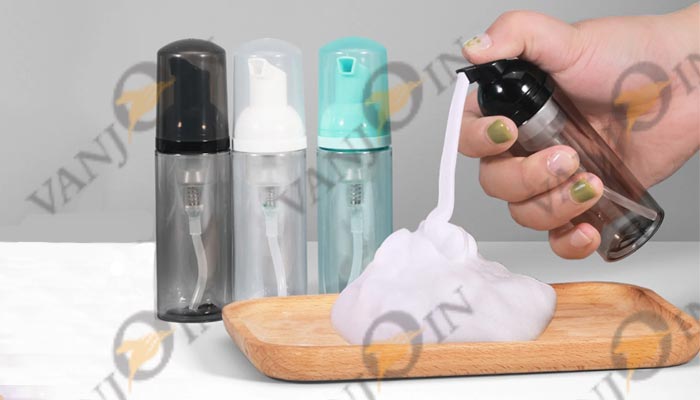
Conclusion
Foam pumps may look simple on the outside — but behind every press is a smart, efficient system designed to elevate product performance, user experience, and sustainability.
Whether you’re formulating a foaming facial cleanser, launching a new hand hygiene line, or optimising packaging for better cost control, understanding how foam pumps work is the first step toward making better packaging decisions.
And with the right partner, it’s easier than ever to bring that vision to life.
At Vanjoin, we combine technical expertise, custom development, and global supply capability — helping brands turn functional components into strategic packaging assets.
Frequently Asked Questions
Q1. Can I use regular soap in a foam pump bottle?
Not directly. Most regular liquid soaps are too thick or concentrated to foam properly. For foam pumps, it’s recommended to dilute your soap with water — often at a 1:3 to 1:5 ratio — and ensure it contains a foaming surfactant.
Q2. Why is my foam pump not working?
Common reasons include: the dip tube isn’t submerged, the formula is too thick, the air intake is blocked, or the mesh screen is clogged. Try priming the pump, checking for obstructions, or testing with a more diluted liquid.
Q3. What type of liquid works best in a foam pump?
Low-viscosity, water-based liquids with surfactants are ideal. Examples include foaming hand wash, facial cleansers, and sanitising liquids. High-viscosity gels, oil-based products, or formulas with particles are not suitable for standard foam pumps.
Q4. How much foam does a pump dispense per stroke?
It depends on the pump model, but most cosmetic foam pumps deliver between 0.4ml to 1.2ml of liquid, which expands into 3–5 times its volume in foam. Vanjoin offers multiple output configurations to suit different use cases.
Q5. Are foam pump bottles recyclable?
Yes, most foam pump bottles are made from recyclable materials like PP or PET, especially when the bottle and pump are the same base polymer. While the pump itself contains multiple components, we can advise on best practices for sustainable design.
Q6. Can foam pumps be used with alcohol-based sanitiser?
Yes — if the formulation includes a small amount of surfactant to stabilise the foam. Vanjoin supplies foam pump systems tested for compatibility with alcohol blends used in medical and hygiene products.
Related Information
